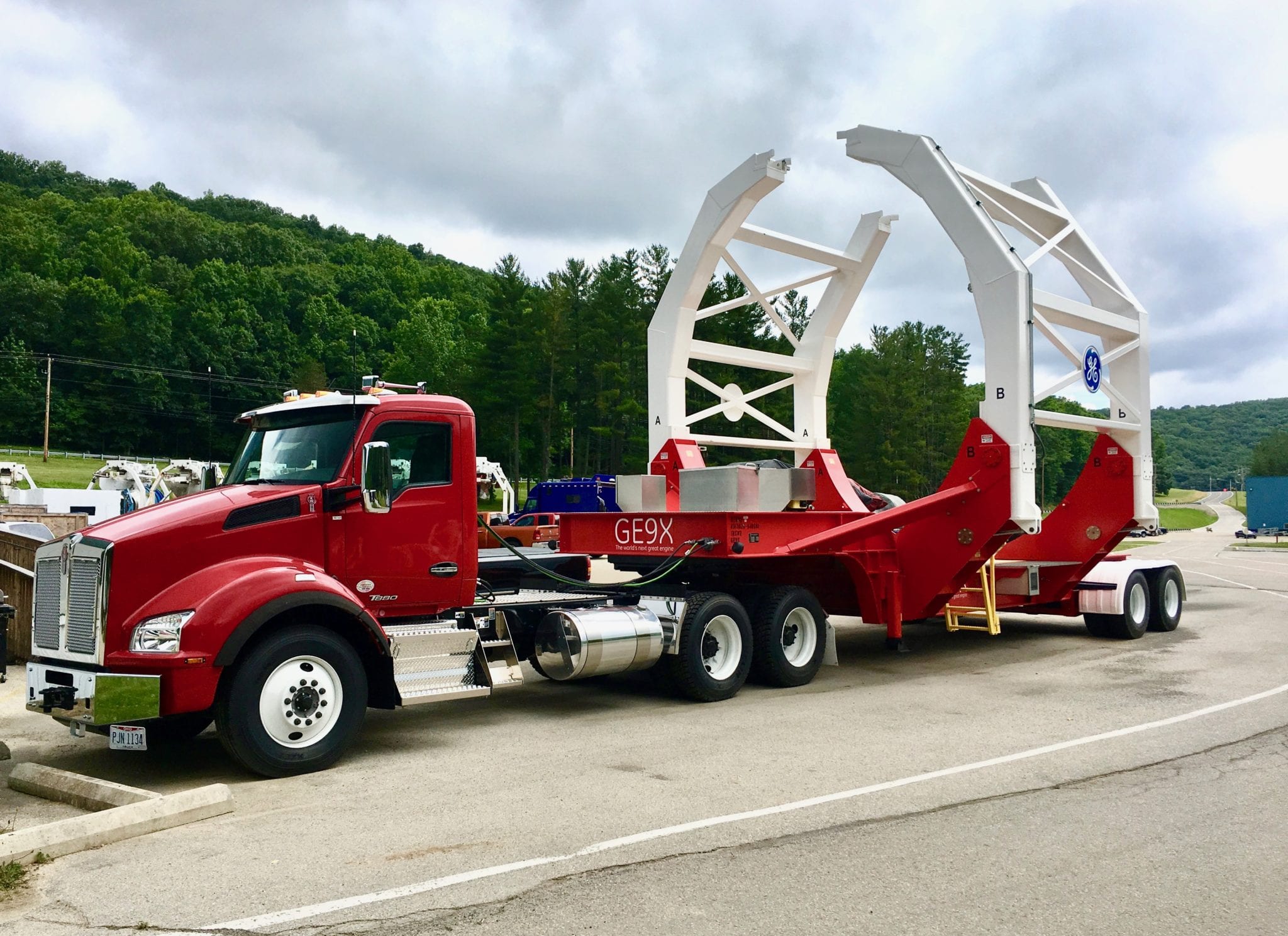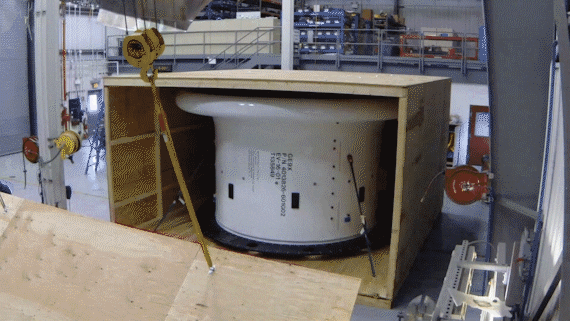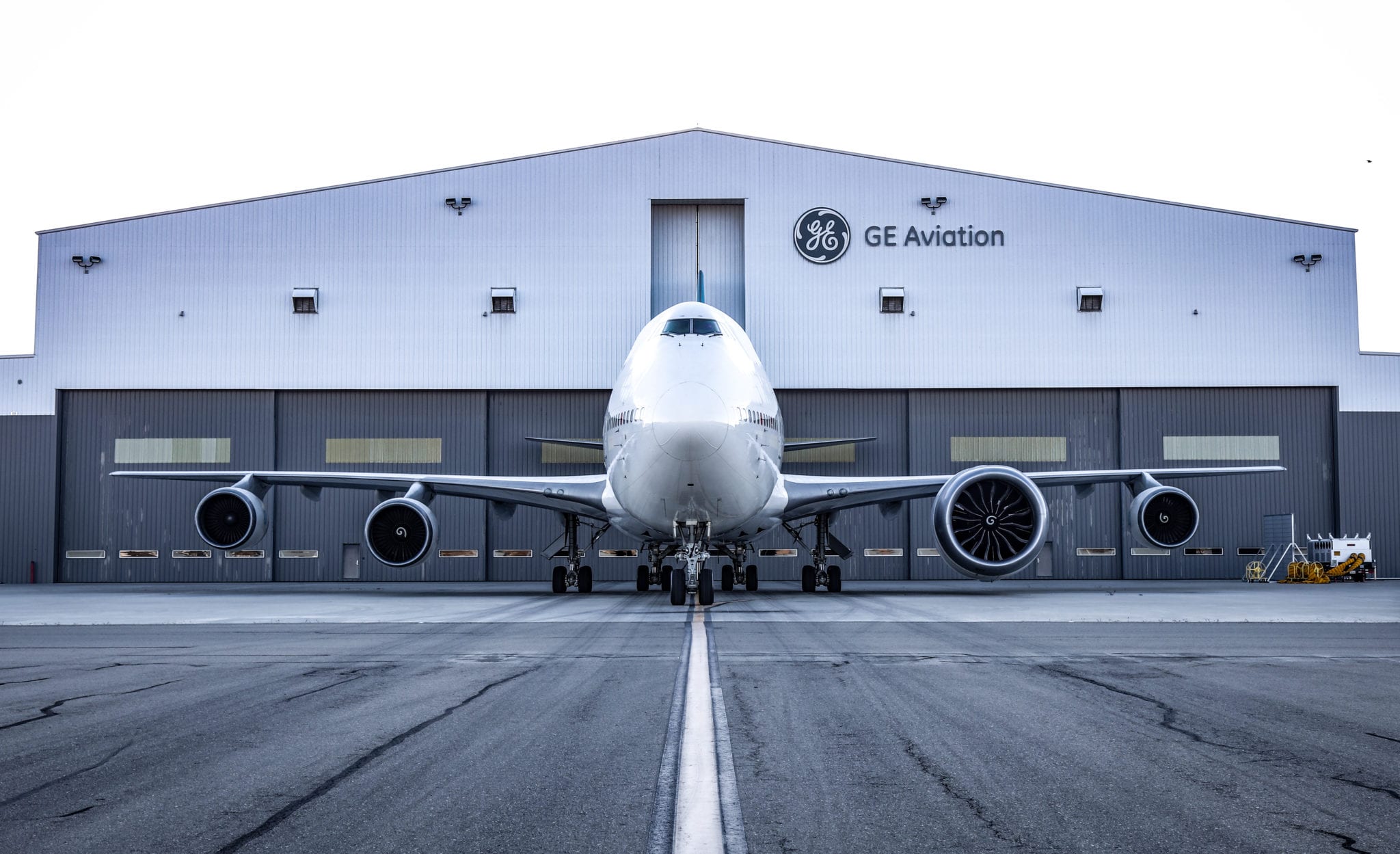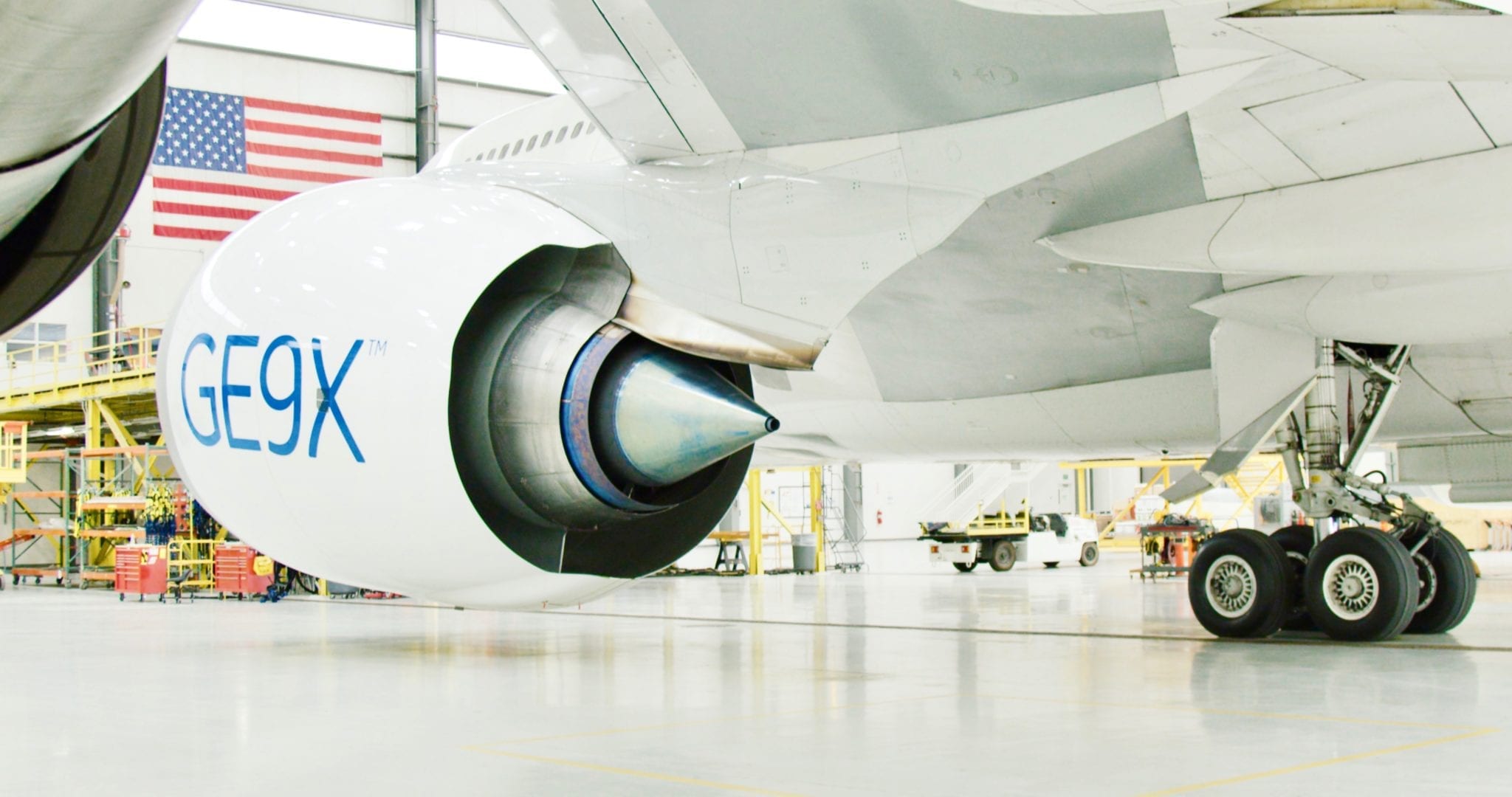We're Going to Need A Bigger Bellmouth: Engineering Solutions for an Engineering Marvel
October 02, 2020 | by Gina Daugherty
The team of innovators at GE Aviation reached a significant milestone this week with the FAA’s certification of the GE9X engine. Designed specifically for Boeing's 777X, the GE9X engine features extraordinarily efficient core technology and a composite fan module optimized for the 777X.
It's also features biggest fan of any commercial engine in the world (a full 11 feet in diameter), along with being the most powerful engine in the world, clocking in at 134,300 pounds of thrust during a test run.
Engineering the world’s largest and most powerful commercial jet engine also means having to engineer ways to transport, test and hang it under the wing of GE’s 747-400 Flying Test Bed.
How exactly do you hang an engine that's as wide as the body of a Boeing 737 under the wing of a Boeing 747? And what happens if the engine is too large for the state roads that lead to a test site?
Here are some of the fascinating, technical challenges GE Aviation engineers overcame on the GE9X engine program.
1. The world’s largest commercial jet engine transporter
The GE9X boasts the world’s largest fan ever produced for a commercial aircraft. Coming in at more than 11 feet in diameter, the engine required a uniquely designed transporter, one that would allow the engine to be carried over the road while staying under the maximum requirements for height.
In order to stay below the max and maintain a height so that the engine didn’t clip powerlines, railroad trestles and other transportation challenges, the team designed the GE9X transporter to use the same footprint as the GE90 transporter. To do this, the trailer nestles down into the pocket trailer, allowing the GE9X to go over the river and through the woods, or at least over roads and across the country to Boeing’s Everett site.
2. Speaking of roads
https://www.instagram.com/p/BylWR5xAo3b/?utm_source=ig_web_copy_link
Every engine program creates its own challenges, and nowhere was that more visibly obvious than the roads around Peebles, Ohio. Every engine is tested at GE Aviation’s Peebles Test Operation in Peebles, a village of under 2,000 people 65 miles east of Cincinnati.
Though the transportation vehicle wasn’t vastly different from one used for the GE90, the issue was when there was more than one GE9X engine coming into or out of testing operations at the same time. For safety reasons and to give the transport vehicles more room, Ohio State Routes 73 and 32 were widened so trucks hauling the GE9X would have more space to accelerate and enough room for two engines to pass each other.
Though the clip above is from inside Peebles’ testing grounds, it gives you an idea of how large the engine is traveling over road.
3. We’re going to need a bigger bellmouth
At a whopping 18 ft in diameter and 15 ft long, the bellmouth inlet for the GE9X is the largest in the world. When it was trucked to Ohio, Highway Patrol measured the shipment at a weigh station because it pushed the concept of “Wide Load” to a new level.
4. Which one of these is not like the others?
Engineers and aviation enthusiasts alike marveled at how peculiar the gigantic GE9X looked on the wing of the GE Aviation Flying Test Bed, a 747-400, especially compared to the three production CF6 engines also on wing. And given the 11-foot diameter of the GE9X, many asked how did engineers account for ground clearance?
The engine is mounted on a unique pylon that cantilevers the engine out in front of the wing and tilts it upward by approximately 7 degrees. In addition, engineers over-serviced the landing gear struts, extending them to provide an additional 4 inches of clearance. The result is about 18 inches of clearance between the bottom of the nacelle and the ground when the test aircraft is sitting stationary.
And given the relatively small clearance, flying in crosswinds presents another challenge. Read about flying in crosswinds with GE Aviation Chief Test Pilot Jon Ohman.
https://blog.geaerospace.com/technology/ge9x-you-have-questions-our-chief-test-pilot-has-answers/
It's also features biggest fan of any commercial engine in the world (a full 11 feet in diameter), along with being the most powerful engine in the world, clocking in at 134,300 pounds of thrust during a test run.
Engineering the world’s largest and most powerful commercial jet engine also means having to engineer ways to transport, test and hang it under the wing of GE’s 747-400 Flying Test Bed.
How exactly do you hang an engine that's as wide as the body of a Boeing 737 under the wing of a Boeing 747? And what happens if the engine is too large for the state roads that lead to a test site?
Here are some of the fascinating, technical challenges GE Aviation engineers overcame on the GE9X engine program.
1. The world’s largest commercial jet engine transporter
 Above: This specially designed trailer allows the GE9X to stay under max requirements for height, ensuring the 11-foot diameter fan is passable on local and state roads. Top: The GE9X engine on wing GE Aviation's 747-400 Flying Test Bed in Victorville, California.
Above: This specially designed trailer allows the GE9X to stay under max requirements for height, ensuring the 11-foot diameter fan is passable on local and state roads. Top: The GE9X engine on wing GE Aviation's 747-400 Flying Test Bed in Victorville, California.
The GE9X boasts the world’s largest fan ever produced for a commercial aircraft. Coming in at more than 11 feet in diameter, the engine required a uniquely designed transporter, one that would allow the engine to be carried over the road while staying under the maximum requirements for height.
In order to stay below the max and maintain a height so that the engine didn’t clip powerlines, railroad trestles and other transportation challenges, the team designed the GE9X transporter to use the same footprint as the GE90 transporter. To do this, the trailer nestles down into the pocket trailer, allowing the GE9X to go over the river and through the woods, or at least over roads and across the country to Boeing’s Everett site.
2. Speaking of roads
https://www.instagram.com/p/BylWR5xAo3b/?utm_source=ig_web_copy_link
Every engine program creates its own challenges, and nowhere was that more visibly obvious than the roads around Peebles, Ohio. Every engine is tested at GE Aviation’s Peebles Test Operation in Peebles, a village of under 2,000 people 65 miles east of Cincinnati.
Though the transportation vehicle wasn’t vastly different from one used for the GE90, the issue was when there was more than one GE9X engine coming into or out of testing operations at the same time. For safety reasons and to give the transport vehicles more room, Ohio State Routes 73 and 32 were widened so trucks hauling the GE9X would have more space to accelerate and enough room for two engines to pass each other.
Though the clip above is from inside Peebles’ testing grounds, it gives you an idea of how large the engine is traveling over road.
3. We’re going to need a bigger bellmouth
 The worlds largest bellmouth, big enough to accommodate the GE9X engine. Also pictured is the GE9X transporter.
The worlds largest bellmouth, big enough to accommodate the GE9X engine. Also pictured is the GE9X transporter.
At a whopping 18 ft in diameter and 15 ft long, the bellmouth inlet for the GE9X is the largest in the world. When it was trucked to Ohio, Highway Patrol measured the shipment at a weigh station because it pushed the concept of “Wide Load” to a new level.
 The ultimate unboxing video, revealing the world's largest bellmouth.
The ultimate unboxing video, revealing the world's largest bellmouth.
4. Which one of these is not like the others?
 The 747 Flying Test Bed with the GE9X on wing along with production CF6 engines.
The 747 Flying Test Bed with the GE9X on wing along with production CF6 engines.
Engineers and aviation enthusiasts alike marveled at how peculiar the gigantic GE9X looked on the wing of the GE Aviation Flying Test Bed, a 747-400, especially compared to the three production CF6 engines also on wing. And given the 11-foot diameter of the GE9X, many asked how did engineers account for ground clearance?
The engine is mounted on a unique pylon that cantilevers the engine out in front of the wing and tilts it upward by approximately 7 degrees. In addition, engineers over-serviced the landing gear struts, extending them to provide an additional 4 inches of clearance. The result is about 18 inches of clearance between the bottom of the nacelle and the ground when the test aircraft is sitting stationary.
 A close-up of the specially designed GE9X pylon for the Flying Test Bed.
A close-up of the specially designed GE9X pylon for the Flying Test Bed.
And given the relatively small clearance, flying in crosswinds presents another challenge. Read about flying in crosswinds with GE Aviation Chief Test Pilot Jon Ohman.
https://blog.geaerospace.com/technology/ge9x-you-have-questions-our-chief-test-pilot-has-answers/





